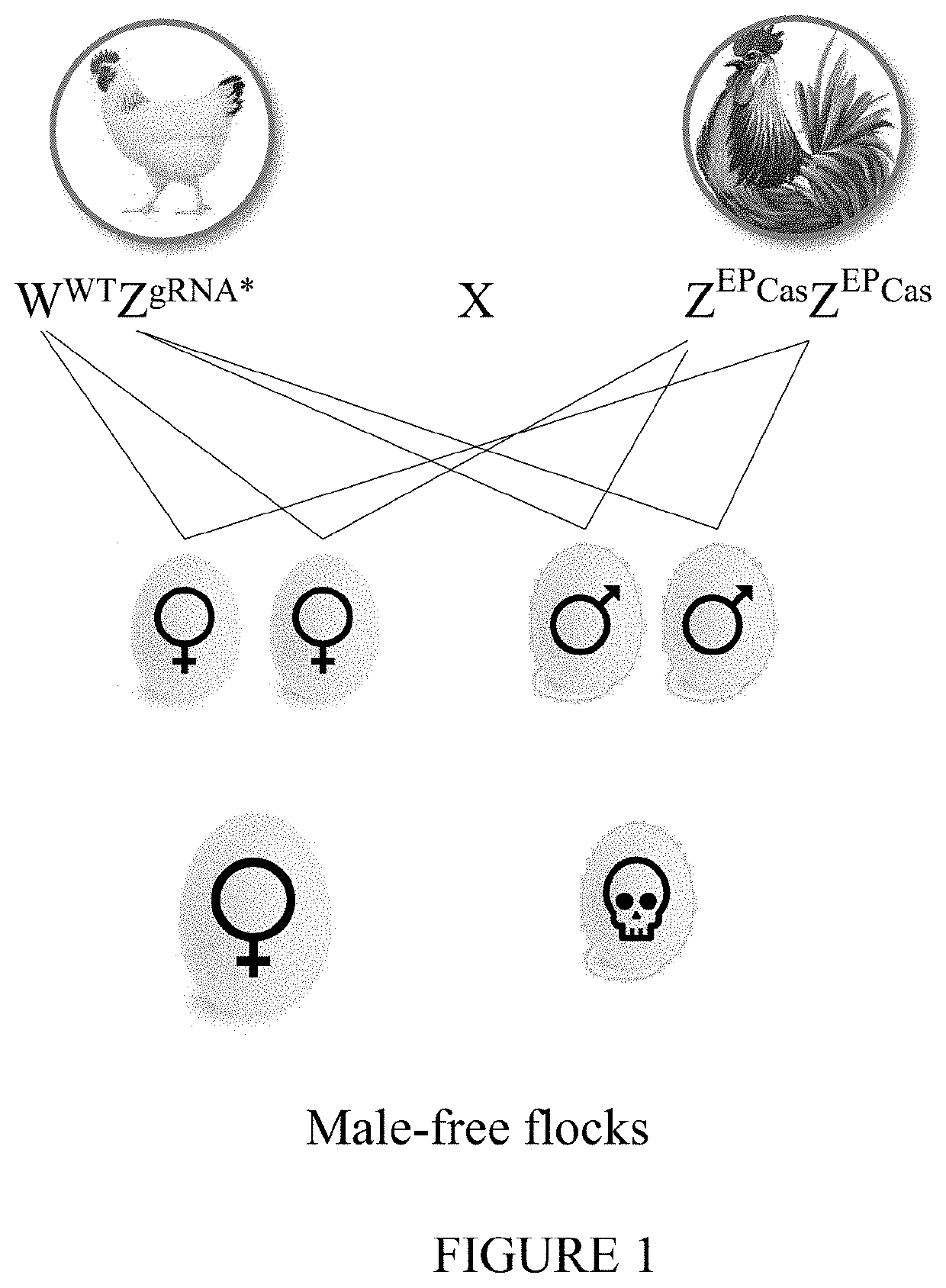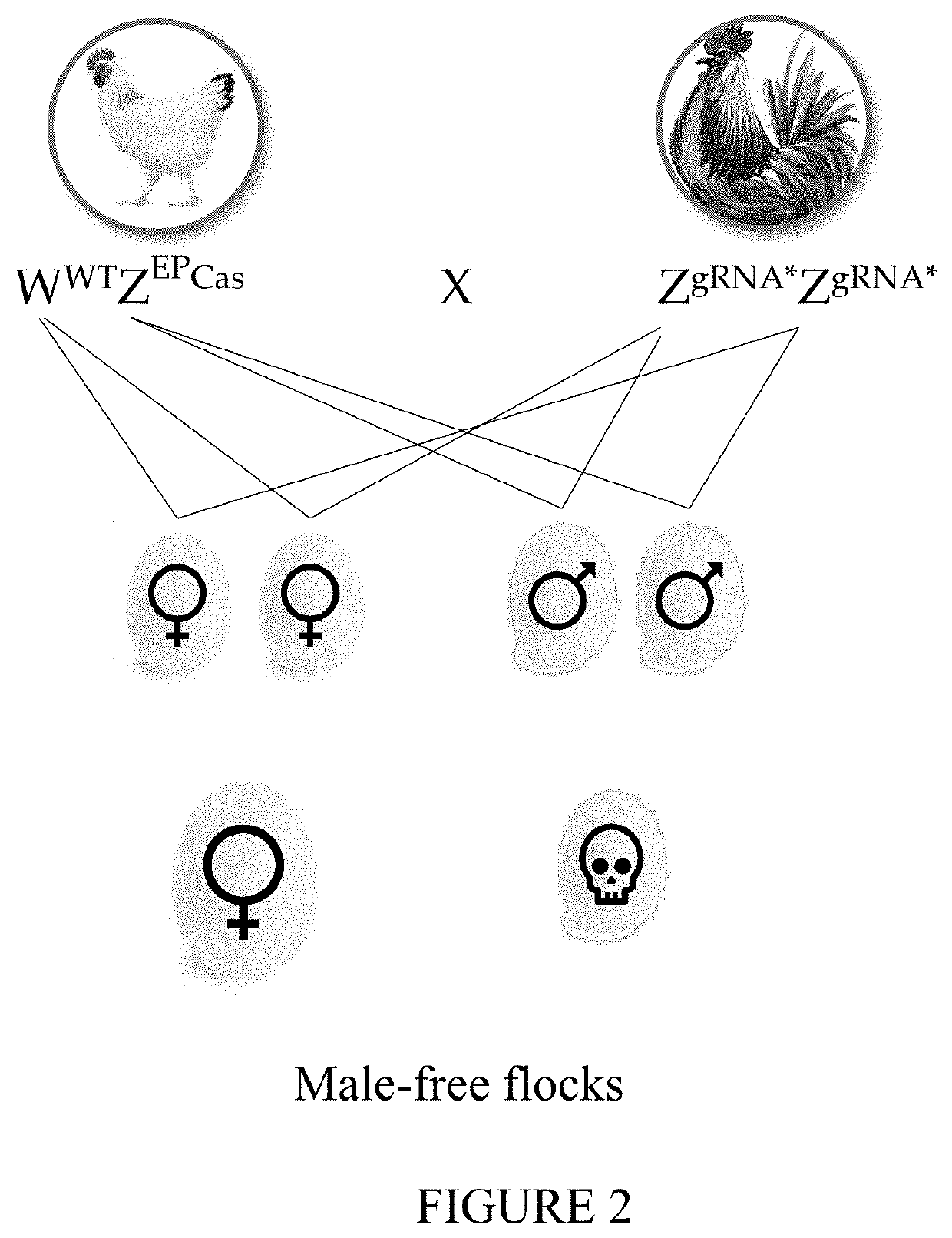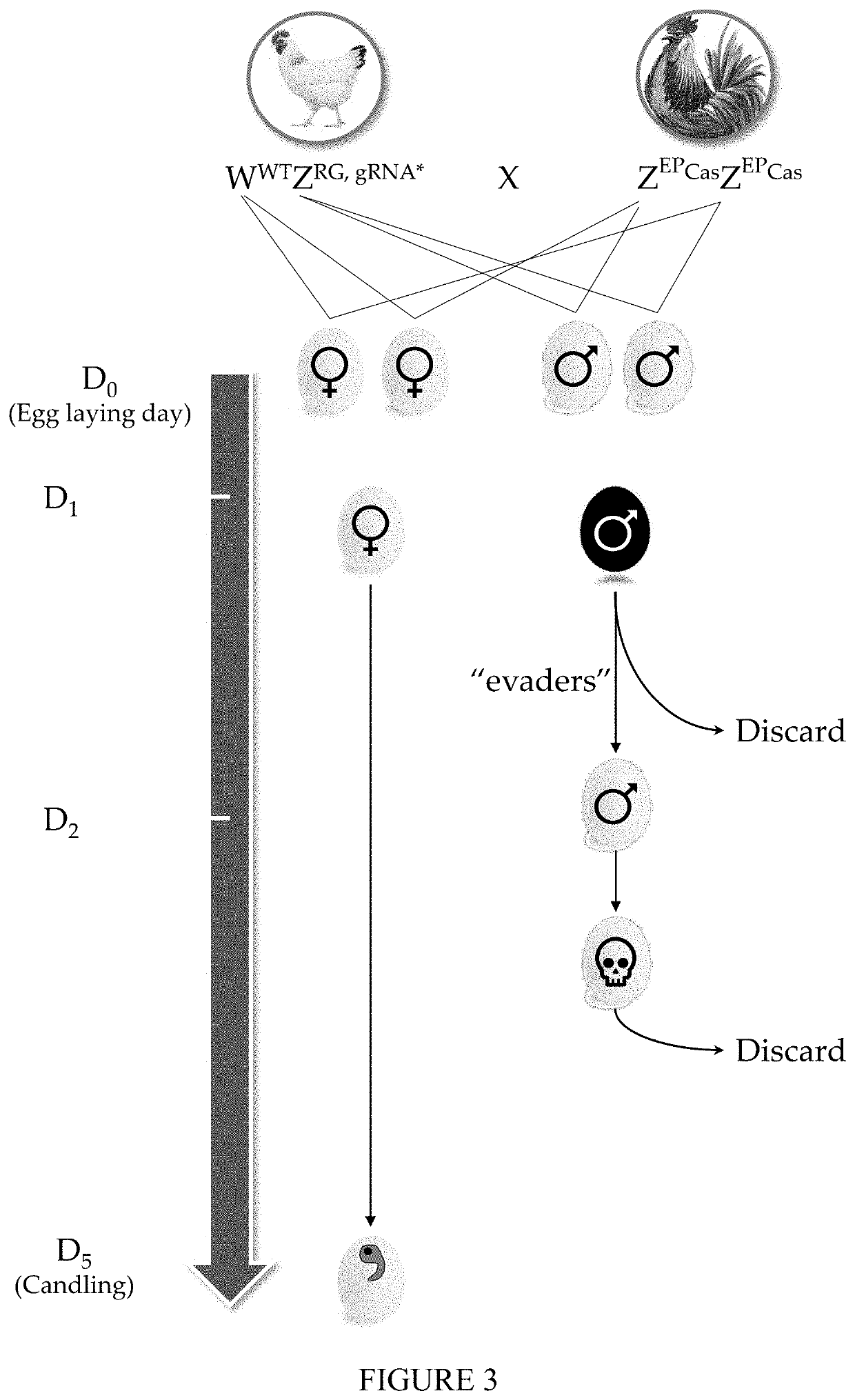Methods for gender determination and selection of avian embryos in unhatched eggs
a technology of avian embryos and gender determination, which is applied in the field of non-invasive methods and transgenic avian animals for gender determination and selection of embryos in unhatched avian eggs, and achieves the effects of high efficiency and selectiveness, and great proficiency
- Summary
- Abstract
- Description
- Claims
- Application Information
AI Technical Summary
Benefits of technology
Problems solved by technology
Method used
Image
Examples
example 1
Obtaining an Avian Transgenic Cell
[0214]The process includes knocking-in a reporter gene (CMV-RFP) to the designated genome loci, which is described hereinbelow.
Preparation of gRNA Duplex:
[0215]Components: Z-specific gRNA oligo (ChrZgRNA sequence: 5′-GUAAUACAGAGCUAAACCAG-3′; SEQ ID NO: 30); tracrRNA (IDT cat #1072533); and Nuclease-Free Duplex Buffer (IDT cat #11-01-03-01).
[0216]RNA oligos are resuspend in Nuclease-Free Duplex Buffer to a final concentration of 100 μM (Micromolar) (for 10 nM (nanomolar) gRNA use 100 μl of Nuclease free buffer). Z-specific gRNA and tracrRNA are mixed in equimolar concentrations to create a final duplex concentration of 1 μM from each oligo (the duplex can be stored in −20° C. for multiple uses). Duplexes are heated at 95° C. for 5 min, and thereafter are cooled to room temperature (20-25 ° C.).
Preparation of RNP Complex and Transfection:
[0217]Components: HiFi Cas9 Nuclease V3 (IDT cat #1081061); Opti-MEM reduced serum media (Thermo cat #11058021); LI...
example 2
Obtaining a Transgenic Embryo / Organism
[0220]In order to generate transgenic chick, primordial germ cells (PGCs) are extracted, manipulated and retrieved to another embryo for the purpose of germ line chimera generation.
Collection of 18 Hamburger Hamilton (HH) Stage Embryonic Blood for the Purpose of PGC Isolation
[0221]Fertilized eggs are incubated in 39° C. incubator for 72 hrs. Following the 72 hrs incubation, eggs are removed from the incubator, and each egg is punctured using a 19 G needle. Three (3) to 5 ml of albumin is drawn from each egg. A “window” is opened in each egg by carefully removing a part of shell. A heated 5 μl pointed capillary is used to cause controlled bleeding from the embryo's vascular system. Up to 5 μl of embryonic blood is collected and deposited into 48-wells plate (48 W) filled with Avian DMEM media. After 1-2 weeks, red blood cells die and PGCs are visible. Fresh medium is replenished every 3 or 4 day. When PGCs reach confluency in the 48 W, they are t...
example 3
Validation of Genome Editing (GE) Event
Validation of Genome Cleavage Using T7EI Enzyme Assay
[0226]Components: GENEART™ Genomic Cleavage Detection Kit (Thermo cat#A24372); gRNA: Cas9 transfected DF1 cells (an ATCC cell line #CRL12203); and detection primers for cleavage with ChrZgRNA: Forward: 5′-GCGGAGGGAGATGAAACA-3′ (SEQ ID NO: 31), and Reverse: 5′-AAGGGATCACACAGCTCAAG-3′ (SEQ ID NO: 32).
[0227]Hundred (100) μl of cell lysis buffer (GeneArt Kit) are mixed with 4 μl of protein degrader (GeneArt Kit), in a microcentrifuge tube. Culture media is removed from transfected cells, which are then added with 100 μl of the cell lysis mix. The cells are then incubated at room temperature for 5 min. Lysed cells are then collected and transfer into a PCR (0.2 μl) tube. The lysed cells are placed in a thermo-cycler and processed according to the following program: 68° C. for 15 min, 95° C. for 10 min, and hold on 4° C. Thereafter, an amplification reaction is set according to the following table:...
PUM
| Property | Measurement | Unit |
|---|---|---|
| Nanoscale particle size | aaaaa | aaaaa |
| Nanoscale particle size | aaaaa | aaaaa |
| Temperature | aaaaa | aaaaa |
Abstract
Description
Claims
Application Information
 Login to View More
Login to View More - R&D
- Intellectual Property
- Life Sciences
- Materials
- Tech Scout
- Unparalleled Data Quality
- Higher Quality Content
- 60% Fewer Hallucinations
Browse by: Latest US Patents, China's latest patents, Technical Efficacy Thesaurus, Application Domain, Technology Topic, Popular Technical Reports.
© 2025 PatSnap. All rights reserved.Legal|Privacy policy|Modern Slavery Act Transparency Statement|Sitemap|About US| Contact US: help@patsnap.com



